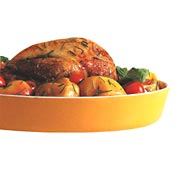|
|
Cuisine Glossary
| You have reached our International Cuisines and information on all aspects of a countries cuisine.
We will try to explain the culture, significant influences, climate, and other factors that have come together to create a distinct style. For example: Spanish, Mexican or Japanese. |
Ethiopian Cuisine
 |
As with its cuisine, landlocked Ethiopia lies somewhat separate from its Mother Africa. Its main borders with Kenya, Somalia, and Sudan can be easily drawn along an encircling rim of high mountain peaks — some of them reaching over 15,000 feet. Transportation is difficult in this terrain, which is why Ethiopia has maintained its purity — relatively uninfluenced by neighboring countries and their invasions over the centuries.
Since the 1400's, traders have introduced some non-indigenous ingredients that have added to what we now know of as authentic Ethiopian cuisine. From Portugal came chile peppers, and from the Orient — ginger. India played a part in North African trade as well, introducing exotic spices. However, gastronomic influences are not altogether obvious in Ethiopian cuisine because it is so different from all others. Ethiopia has been described as the land of bread and honey. Grains including sorghum, millet, teff, and wheat grow well in the temperate climate. And honey, collected by ancient beekeeping techniques, is used in everyday meals. Ethiopian food is the ultimate in living off of the land. Source: HungryMonster Writers |




